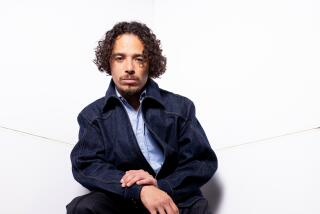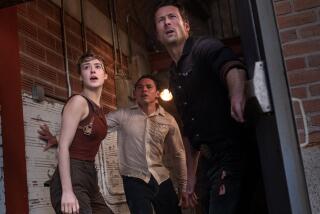Review: ‘Everest’ is a close look at 1996 disaster. Maybe too close.
- Share via
The tale of mountaineering derring-do told in “Everest” would seem ideally suited for presentation in Imax 3-D, and it is. Up to a point.
Starring Jason Clarke, Josh Brolin, John Hawkes and Jake Gyllenhaal, and directed by Icelandic director Baltasar Kormákur in that immersive format, this story of a day in 1996 that was one of the deadliest in climbing history showcases both the splendors and the limitations of that big-screen presentation.
As shot by cinematographer Salvatore Totino, “Everest” is rife with spectacular mountain vistas photographed either in Nepal or the Italian Alps (where much of the filming actually took place).
SIGN UP for the free Indie Focus movies newsletter >>
Astonishing images of situations, such as fixed ladders extended over bottomless crevices and aerial shots of flimsy bridges hovering above daunting chasms, make the experience of high-altitude climbing look as terrifying as it is exhilarating, which seems just about right. “Everest” definitely puts you on the mountain, no questions asked.
But, as it turns out, Imax 3-D works better for yaks than it does for people. Enormous close-ups of actors feel intrusive instead of involving as well as having the odd effect of underlining that the re-creations of the harrowing events on the mountain are not the real thing.
Not helping is that the script by veteran screenwriters William Nicholson (“Gladiator,” “Unbroken”) and Simon Beaufoy (“Slumdog Millionaire,” “127 Hours”) is standard issue in terms of both drama and characterization, with lines like “Go or I’ll cry” making frequent appearances.
And this despite the fact that “Into Thin Air,” Jon Krakauer’s bestselling book about being a climber on that ill-fated 1996 expedition, was noticeably well-written. Though Krakauer is a character in the film (he’s played by Michael Kelly of “House of Cards”), “Everest” is based on other source material and not on Krakauer’s book.
Krakauer is in fact on everyone’s mind when “Everest” opens in New Zealand with the team from Adventure Consultants getting ready for the 1996 climbing season in the Himalayas.
Headed by Rob Hall, Adventure Consultants was a pioneer in getting amateur climbers (Krakauer’s book calls them “Walter Mittys with Everest dreams”) to the top of the mountain.
Hall excitedly tells Helen Wilton (Emily Watson), his base camp manager, that Outside Magazine writer Krakauer, who was previously going to describe an Everest climb with rival company Mountain Madness, has switched firms and is going to climb with them, a reversal that should be good for business.
Clarke, an Australian actor known for “Zero Dark Thirty” and “Dawn of the Planet of the Apes,” does some of the best work of his career as the capable and solicitous Hall, a man who worries about his clients and Dr. Jan Arnold (Keira Knightley), the pregnant wife he is leaving behind to lead the Everest climb. “Be back for the birth,” she tells him, and he replies, “Try and stop me.” Yes, it’s like that.
First stop for everyone is Katmandu in Nepal, where we meet the paying customers Adventure Consultants hopes to take to the top. These include the wonderfully named Beck Weathers (Brolin), a cocky Texan with an unflappable wife named Peaches (Robin Wright) back home, and Doug Hansen (Hawkes), a completely ordinary mailman who just missed getting to the summit the year before.
Because the amateur climbing business has skyrocketed, Everest base camp is as busy as Times Square, so much so that Hall decides to temporarily team up with his rival at Mountain Madness, the ultra-charismatic but laid-back Scott Fischer (who else but Gyllenhaal).
On that fateful May day on the mountain, some problems, like a terrible storm, are acts of God, but others are the product of human error and personality. Ego has led these climbers to Everest, and ego ultimately makes it difficult for them to get back down safely.
The real story “Everest” is based on is a complicated one, and the film attempts to touch a lot of those bases, maybe too many — for instance, giving a nod to climber Sandy Hill Pittman, who became infamous for bringing an espresso machine to base camp.
Once the push to the summit begins, “Everest” suffers not only because it gives screen time to too many secondary characters but also because it becomes hard to tell all these people apart once they are bundled into their gear and covered in snow.
Though there is heroism as well as love here, because it involves the deaths of people we have come to care about, “Everest” is finally a sad story, though not always a dramatically involving one. If you’re looking for great mountain climbing films, documentaries like “Meru” and “The Summit” will take you higher than “Everest,” world-class visuals and all.
Twitter: @KennethTuran
------------
‘Everest’
MPAA rating: PG-13 for intense peril and disturbing images
Running time: 2 hours, 1 minute
Playing: In general release
More to Read
Only good movies
Get the Indie Focus newsletter, Mark Olsen's weekly guide to the world of cinema.
You may occasionally receive promotional content from the Los Angeles Times.











